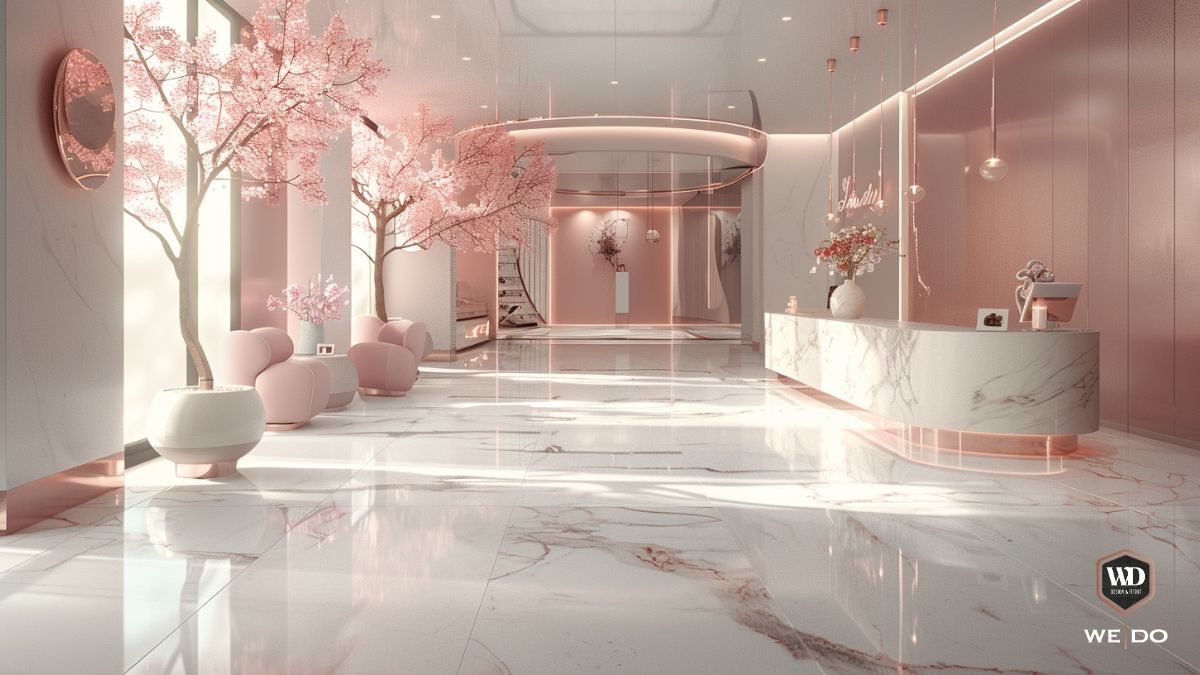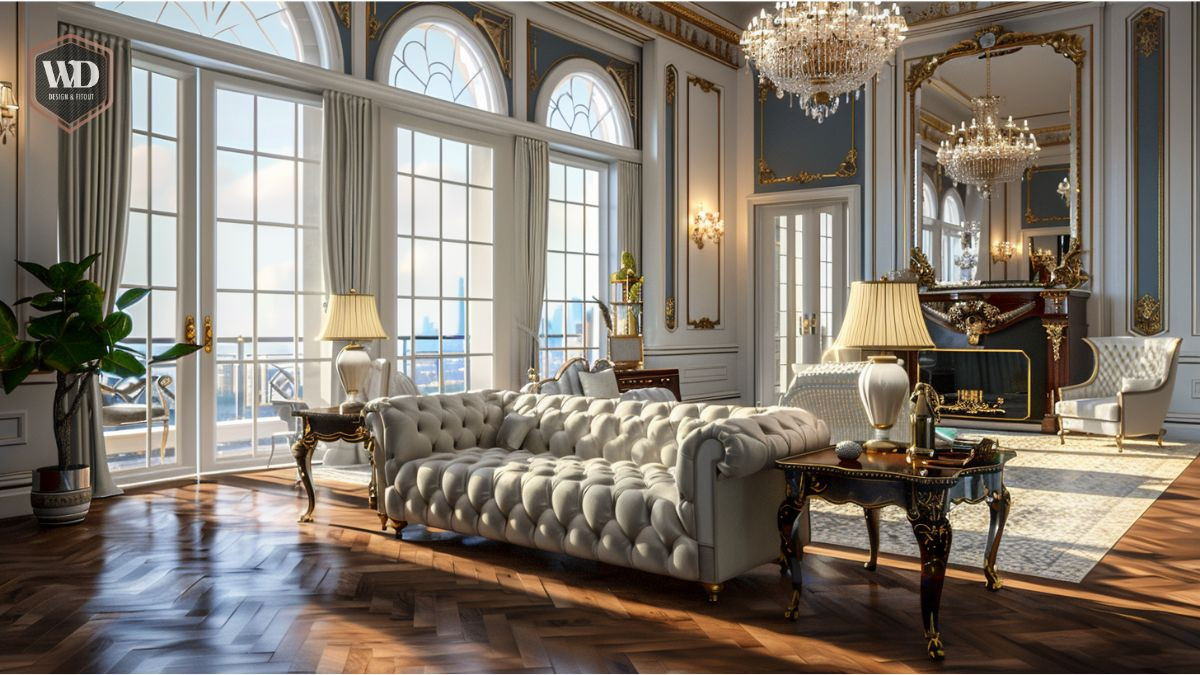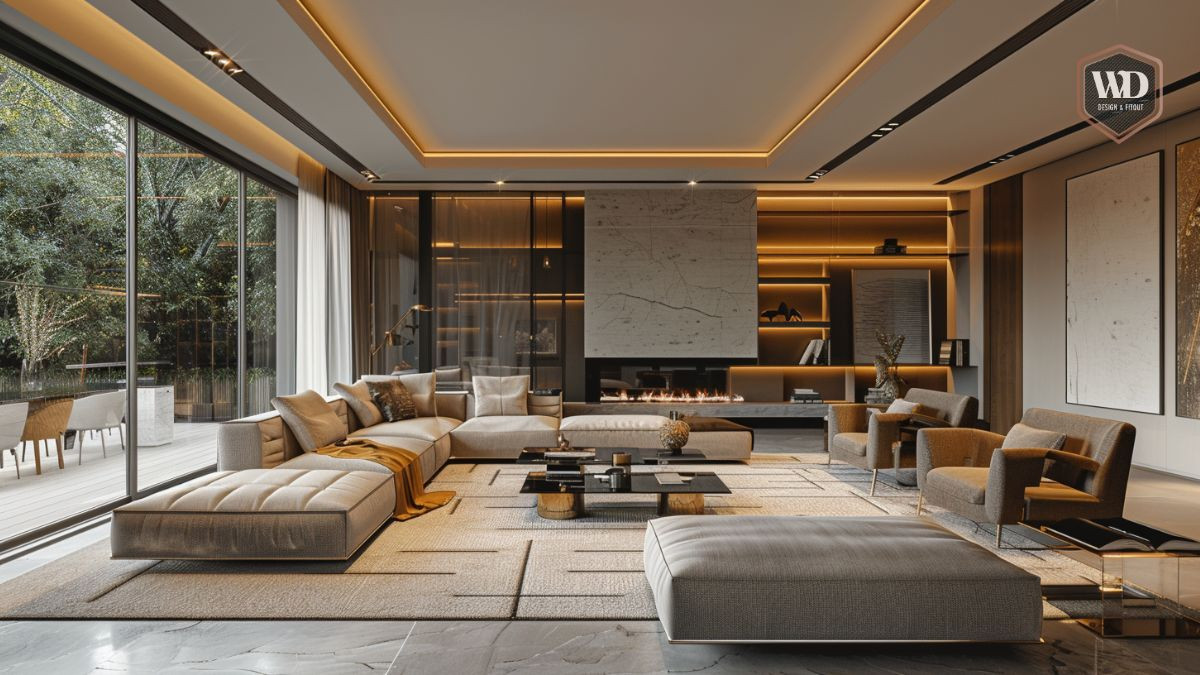Introduction
Interior design is the art and science of enhancing the interior of a space to achieve a healthier and more aesthetically pleasing environment for the people using the space. It involves a comprehensive understanding of architecture, furniture design, colour theory, and spatial arrangements to create functional and beautiful interiors.

Importance of Interior Design
Interior design is crucial because it significantly impacts our quality of life, productivity, and well-being. Thoughtfully designed interiors can boost our mood, enhance functionality, and improve the overall aesthetic appeal of our homes and workplaces.
Objectives of Interior Design
The primary objective of interior design is to create functional and visually appealing spaces. This involves ensuring the space is usable, safe, and designed with the occupants’ needs in mind while reflecting their style and preferences.
Historical Context
Early Beginnings of Interior Design
Interior design can trace its origins back to ancient civilizations. Egyptians decorated their homes with murals and furniture, while Greeks used intricate patterns and luxurious materials. These early efforts were more about comfort and practicality rather than aesthetics.
Evolution Through the Centuries
During the Renaissance, interior design began to take on a more artistic form, focusing on symmetry, proportion, and balance. The Victorian era introduced a more eclectic and decorative style. At the same time, the modernist movement of the 20th century focused on simplicity, functionality, and the use of new materials and technologies.
Influence of Cultural Movements
Cultural movements have always influenced interior design. The Art Deco movement brought bold geometric patterns and luxurious materials, while the mid-century modern style emphasized clean lines and organic forms. Today, global influences are seen in design styles incorporating elements from various cultures worldwide.
Critical Principles of Interior Design
Balance
Balance in interior design is the distribution of visual weight in a room. This can be achieved through symmetrical, asymmetrical, or radial balance. Symmetrical balance involves mirroring elements on either side of a central axis, while asymmetrical balance uses different elements to create a sense of equilibrium. Radial balance arranges elements around a central point.
Harmony and Unity
Harmony and unity ensure that all elements in a space work together cohesively. This involves consistent style, colour scheme, and theme throughout the space. When harmony and unity are achieved, the space feels organized and intentional.
Rhythm
Rhythm in interior design refers to creating patterns of repetition and contrast to move the eye around the room. This can be achieved through repeating colours, shapes, or textures and creating a visual flow from one area to another.
Proportion and Scale
Proportion and scale deal with the size of objects about each other and the space they occupy. Proper proportion and scale ensure that the elements in a room feel balanced and harmonious.
Emphasis
Emphasis involves creating a focal point in a room to draw attention. This could be a piece of artwork, a fireplace, or a feature wall. Emphasis helps to anchor the room and provide visual interest.
Design Styles and Trends
Traditional
The traditional design is rooted in classic European styles and features rich colours, elaborate details, and a focus on comfort and symmetry. This style often includes antiques, dark woods, and luxurious fabrics.
Modern
Modern design emphasizes simplicity, clean lines, and a lack of clutter. It often incorporates industrial materials like glass, metal, and concrete and uses a neutral palette with bold accent colours.
Contemporary
Contemporary design is ever-evolving and reflects current trends. It focuses on simplicity, sophistication, and modern materials and technology use. Unlike modern design, contemporary design is not tied to a specific period.
Minimalist
Minimalist design is characterized by simplicity and functionality. It uses a limited colour palette, often monochromatic, and eliminates unnecessary items to create a clutter-free space.
Industrial
Industrial design draws inspiration from warehouses and factories. It features exposed brick, metal beams, and unfinished surfaces. This style often incorporates salvaged or repurposed materials.
Scandinavian
Scandinavian design emphasizes simplicity, functionality, and a connection to nature. It uses light colours, natural materials, and clean lines to create a bright, airy space.
Bohemian
Bohemian design is eclectic and free-spirited. It incorporates a mix of colours, patterns, and textures, often using vintage and handmade items to create a personalized and unique space.
Transitional
The transitional design blends traditional and contemporary elements. It balances the classic appeal of conventional design with the clean lines and simplicity of modern style.
Eclectic
The eclectic design combines elements from various styles and periods. It allows for creative freedom and personal expression, creating a unique and personalized space.
Coastal
The beach and ocean inspire coastal design. It uses light, airy colours, natural materials, and nautical elements to create a relaxed and breezy atmosphere.
Room-by-Room Design Tips

Living Room
The living room is often the focal point of the home. Consider the layout and traffic flow to create a functional and inviting space. Choose comfortable seating, use area rugs to define spaces, and incorporate personal touches with decor and artwork.
Bedroom
The bedroom should be a relaxing retreat. Choose a calming colour palette, invest in quality bedding, and ensure adequate storage solutions. Consider adding personal touches like family photos or favourite books.
Kitchen
In the kitchen, functionality is critical. Ensure a good workflow with sink, stove, and refrigerator placement placement. Use durable and easy-to-clean materials, and incorporate plenty of storage.
Bathroom
The bathroom should be both functional and serene. Use moisture-resistant materials, ensure good lighting, and consider adding elements like a heated towel rack or a rainfall showerhead for a touch of luxury.
Dining Room
The dining room should be a space for gathering and entertaining. Choose a table that fits the size of the room and the number of people you typically entertain. Use comfortable seating and consider adding a statement lighting fixture.
Home Office
In the home office, focus on creating a productive workspace. Ensure good lighting, use ergonomic furniture, and incorporate plenty of storage for supplies and documents. Personalize the space with decor that inspires you.
Children’s Room
Children’s rooms should be fun and functional. Use bright colours and playful decor, ensure plenty of storage for toys and clothes, and create areas for play, study, and rest.
Colour Theory in Interior Design
Basics of Color Theory
Colour theory is the study of how colours interact and the effects they have on our perception and emotions. Understanding the colour wheel, primary, secondary, and tertiary colours, and how to create harmonious colour schemes is essential in interior design.
Colour Psychology
Colour psychology explores how colours affect mood and behaviour. For example, blue is calming, red is energizing, and yellow is uplifting. Choosing the right colours can create the desired atmosphere in a space.
Creating Color Schemes
Creating a colour scheme involves selecting a combination of colours that work well together. Typical colour schemes include monochromatic, analogous, complementary, and triadic. Using a colour wheel can help you choose harmonious colours.
Use of Neutrals and Accents
Neutrals, such as white, grey, and beige, provide a versatile backdrop that can be paired with various accent colours. Accents add visual interest and can be changed easily to update the look of a space.
Furniture Selection and Arrangement
Choosing the Right Furniture
Choosing the right furniture involves considering each piece’s size, style, and function. Furniture should be comfortable, durable, and suited to its space. It should also reflect the overall design style of the room.
Arranging Furniture for Functionality
Furniture arrangements should promote ease of movement and functionality. Consider the room’s focal point, traffic flow, and the purpose of the space. Arrange furniture to create conversation areas, workspaces, and relaxation zones.
Incorporating Multi-Functional Pieces
Multi-functional furniture, such as sofa beds, storage ottomans, and extendable tables, can maximize space and versatility. These pieces are instrumental in small spaces where flexibility is essential.
Lighting in Interior Design
Types of Lighting
The three main lighting types are ambient, task, and accent. Ambient lighting provides overall illumination, task lighting is for specific activities, and accent lighting highlights particular features or decor.
Importance of Natural Light
Natural light enhances a space’s appearance and positively affects mood and health. Use windows, skylights, and glass doors to maximize natural light, and consider light-filtering window treatments.
Creating Ambiance with Artificial Lighting
Artificial lighting can create different moods and atmospheres. Use dimmers to adjust light intensity and combine various types of lighting to achieve the desired effect. Interior Design considers the colour temperature of light bulbs, as warmer tones create a cosy atmosphere while cooler tones are more energizing.

Textiles and Materials
Choosing Fabrics and Textures
Fabrics and textures add depth and interest to a space. Choose materials that are appropriate for the function of the room and the desired look and feel. Consider durability, ease of maintenance, and comfort.
Sustainable and Eco-Friendly Materials
Sustainable materials like bamboo, recycled metals, and organic fabrics are environmentally friendly. These materials reduce environmental impact and contribute to a healthier indoor environment.
Mixing and Matching Textiles
Mixing and matching textiles can create a layered and dynamic look. Combine different patterns, colours, and textures to add visual interest. Ensure a common element, such as colour or style, is used to tie the different textiles together.
Decorative Accessories
Importance of Accessories
Accessories are the finishing touches that complete a room. They add personality, colour, and texture and can be easily updated to refresh the look of a space.
Selecting Art and Decor
Choose art and decor that reflect your style and interests. Consider the scale and proportion of the pieces and arrange them to create a balanced and cohesive look. Grouping items in odd numbers often creates a more visually appealing arrangement.
Using Plants in Interior Design
Plants add life and colour to a space and can improve indoor air quality. Choose plants that suit the room’s light conditions and consider using various sizes and types for a more exciting display.
Space Planning and Layouts
Understanding Space Planning
Space planning involves arranging furniture and decor to maximize functionality and flow. Consider the space’s purpose, the occupants’ needs, and the room’s architectural features.
Common Layout Mistakes
Common layout mistakes include placing furniture too close or far apart, blocking traffic flow, and ignoring focal points. Avoid these mistakes by planning the layout before arranging furniture and decor.
Optimizing Small Spaces
Optimizing small spaces involves using furniture and decor that maximize space and functionality. Interior Design: Use multi-functional furniture, vertical storage, and light colours to make the space more significant and open.

Storage Solutions
Creative Storage Ideas
Creative storage solutions help keep a space organized and clutter-free. Consider using under-bed storage, floating shelves, and built-in cabinets. Use baskets, bins, and boxes to keep smaller items organized.
Built-In Storage
Built-in storage, such as custom closets, cabinetry, and shelving, can maximize space and provide a seamless look. These solutions are beneficial in small spaces or awkwardly shaped rooms.
Storage in Small Spaces
In small spaces, storage is crucial. Use every available inch, including vertical space, under furniture, and behind doors. Choose furniture with built-in storage and use organizers to keep items neatly arranged.
Smart Home Integration
Basics of Smart Home Technology
Smart home technology includes devices and systems that automate and control various aspects of the home, such as lighting, heating, security, and entertainment. These technologies can be controlled remotely using smartphones or voice commands.
Popular Smart Home Devices
Popular smart home devices include smart thermostats, bright lighting, smart locks, and smart speakers. These devices offer convenience, energy efficiency, and enhanced security.
Designing for Technology
Designing for technology involves integrating smart devices seamlessly into the home. Consider the placement of outlets and charging stations, conceal wiring, and choose devices that complement the overall design style.
Renovation and Remodeling Tips
Planning a Renovation
Renovation planning involves setting clear goals, creating a budget, and developing a timeline. Please review the project’s scope, desired outcome, and potential challenges.
Budgeting and Cost Management
Budgeting and cost management are crucial for a successful renovation. Set a realistic budget, account for unexpected expenses, and prioritize spending on high-impact areas. Get multiple quotes from contractors to ensure competitive pricing.
Working with Contractors
Working with contractors requires clear communication and a well-defined contract. Choose reputable contractors, establish a timeline, and maintain regular communication to ensure the project stays on track.
Sustainability in Interior Design
Principles of Sustainable Design
Sustainable design principles include using eco-friendly materials, reducing energy consumption, and minimizing waste. Consider the lifecycle of materials and the environmental impact of design choices.
Green Building Materials
Green building materials include recycled, reclaimed, and sustainably sourced materials. Examples are reclaimed wood, recycled metal, and low-VOC (volatile organic compound) paints.
Energy Efficiency Tips
Energy efficiency can be improved through proper insulation, energy-efficient appliances, and smart home technology. Use LED lighting, programmable thermostats, and energy-efficient windows to reduce energy consumption.
Personalizing Your Space
Incorporating Personal Style
Incorporating personal style involves using decor and furnishings that reflect your personality and interests. This could include artwork, collectables, or custom-made items.
DIY Decor Projects
DIY decor projects add a personal touch and can be a cost-effective way to update a space. Consider creating your artwork, repurposing furniture, or making decorative accessories.
Repurposing and Upcycling
Repurposing and upcycling involve giving new life to old or unused items. This could include refinishing furniture, using reclaimed materials, or transforming everyday objects into decor.
Expert Insights
Tips from Professional Designers
Professional designers offer valuable insights into creating functional and beautiful spaces. They emphasize the importance of planning, choosing quality materials, and paying attention to details.
Common Mistakes to Avoid
Common mistakes to avoid include choosing the wrong scale of furniture, ignoring lighting, and neglecting storage. Proper planning and consideration of all design aspects can help avoid these pitfalls.
Future Trends in Interior Design
Future trends in interior design include a focus on sustainability, the use of intelligent technology, and the incorporation of global influences. Biophilic design, which connects interior spaces with nature, is also gaining popularity.
Case Studies
Successful Interior Design Projects
Case studies of successful interior design projects provide inspiration and insights. These projects often showcase creative solutions to design challenges and demonstrate the impact of thoughtful design.
Before and After Transformations
Before and after transformations highlight the dramatic changes that can be achieved through interior design, they provide a visual representation of the design process and the final result.
Lessons Learned from Real-Life Examples
Lessons learned from real-life examples offer practical advice and insights. They highlight the importance of planning, flexibility, and attention to detail in a successful design.
Resources for Further Learning
Recommended Books
Many excellent books on interior design offer inspiration and practical advice. Some recommended titles include “The Interior Design Handbook” by Frida Ramstedt, “Elements of Style” by Erin Gates, and “The Perfectly Imperfect Home” by Deborah Needleman.
Online Courses
Online courses provide an accessible way to learn about interior design. Platforms like Udemy, Coursera, and Skillshare offer classes on interior design, from colour theory to space planning.
Interior Design Blogs and Websites
Interior design blogs and websites offer a wealth of information and inspiration. Some popular sites include Houzz, Apartment Therapy, and Design Sponge. These resources provide ideas, tips, and real-life examples of interior design projects.
Conclusion
Interior design is a multifaceted discipline that combines art and science to create functional and aesthetically pleasing spaces. Fundamental principles include balance, harmony, rhythm, proportion, and emphasis. Understanding design styles, colour theory, furniture selection, lighting, and textiles is essential for creating beautiful interiors.






